How To Clean Printhead On Hp Officejet Pro 8620
Z7_3054ICK0KGTE30AQO5O3KA30N0
hp-concentra-wrapper-portlet
![]() Actions
Actions
HP OfficeJet Printers - Fixing Print Quality Problems
This document is for HP OfficeJet 8600 Series printers, Officejet Pro 8610, 8615, 8616, 8620, 8625, 8630, 8640, and 8660 e-All-in-One printers.
The quality of a printed document or photo is not as expected. The procedures in this document should help with streaked or faded printouts, color or black ink not printing, documents with blurred or fuzzy text, ink streaks or smears, and other print quality problems.
Solution one: Use genuine HP cartridges
HP recommends that you use genuine HP ink or toner supplies. HP cannot guarantee the quality or reliability of non-HP or refilled cartridges. If you do not use genuine HP cartridges, the steps in this document might not resolve the issue. To check the authenticity of your cartridges, go to the HP anti-counterfeit webpage (in English).
Purchase replacement cartridges and other supplies from the HP Store or local retailers.
Solution two: Allow automatic servicing to complete
Many print quality problems with black ink, such as poor black text or issues that occur with a newly installed black cartridge, clear up with the printer's automatic servicing routine. There is nothing you need to do. The print quality should start improving in a few hours.
-
If waiting for automatic servicing to complete resolved the issue, you do not need to continue troubleshooting.
-
If waiting for automatic servicing to complete did not resolve the issue, continue to the next solution.
I cannot wait for automatic servicing to complete
If you cannot wait for the automatic servicing to complete, cleaning the printhead could help. Follow these steps to clean the printhead.
note:Cleaning the printhead uses more ink than the automatic printer servicing.
caution:Never turn off the printer when ink cartridges are not installed. To avoid issues that require cleaning the printhead or that can damage the ink system, always replace ink cartridges as soon as possible, and always turn off the printer using the Power button.
-
Load plain white paper into the tray.
-
On the printer control panel, swipe the display to scroll to Setup, and then touch the Setup icon (
 ). The Setup menu displays.
). The Setup menu displays. -
Swipe the display to scroll to Tools, and then touch Tools.
-
Touch Clean Printhead.
note:
Mechanical noises during the cleaning process are normal.
-
When the first cleaning stage completes, a test page prints. Examine the test page for print quality.
-
If these steps resolved the issue, touch No to skip the other cleaning stages. You do not need to continue troubleshooting.
-
If the issue persists, touch Yes to start the second cleaning stage.
-
-
When the second cleaning stage completes, a test page prints. Examine the test page for print quality.
-
If these steps resolved the issue, touch No to skip the last cleaning stage. You do not need to continue troubleshooting.
-
If the issue persists, touch Yes to start the last cleaning stage.
-
-
When the last cleaning stage completes, a test page prints. Touch OK, and then examine the test page for print quality.
-
If these steps resolved the issue, you do not need to continue troubleshooting.
-
If the issue persists, continue to the next solution.
-
Solution three: Check the paper
Follow these guidelines to make sure that the paper you are using is appropriate for the print job. If it is not, reload the printer with an appropriate paper type.
-
Load the paper print side down in the input tray. Many papers have printing and nonprinting sides, such as photo paper and envelopes. Usually, the smoother side is the "print side," and sometimes the non-print side has a logo of the paper manufacturer on it.
-
Do not use wrinkled or curled paper. Use only clean, wrinkle-free paper.
-
Use the correct paper type for your project.
-
For everyday text documents, plain paper with ColorLok technology works well. Paper with ColorLok technology is industry-standard paper that works well with HP ink.
-
For documents with dense printing, such as high contrast graphics or photos, use HP Advanced Photo Paper for best results.
-
Some paper might not absorb ink as well as others. If your prints smear easily, make sure you are using a recommended paper.
-
-
Store photo paper in its original packaging inside a resealable plastic bag. Store the paper on a flat surface in a cool, dry place. Load 10-20 sheets of photo paper only when you are ready to print, and then put the unused paper back in the packaging.
-
Try using a different paper. This determines if the problem is related to the paper.
note:Inappropriate paper usually causes vertical streaks in printouts (or if the problem occurs on a copy, dirty scanner glass usually causes the issue). Do not replace cartridges to fix vertical streaks.
| Examples of horizontal streaks and vertical streaks in the printout | |
| Figure : Horizontal streaks in printout | Continue with the following troubleshooting steps if your printout contains horizontal streaks or other print quality issues besides vertical streaks. |
| Figure : Vertical streaks in printout | Do not replace cartridges for vertical streaks in a printout. Instead, check the paper as described earlier in this document or search for a document that covers this issue. |
After trying the preceding guidelines, try printing again.
Solution four: Check the print settings
Check the print settings to make sure that they are appropriate for your print job.
Windows 8
-
In the software application you are trying to print from, click File, and then click Print.
The Print window opens.
-
Open the Properties dialog box.
Depending on the software application, the button might be Properties, Options, Printer Setup, Printer, or Preferences.
-
Depending on your print job, you might consider modifying the following settings:
-
Paper Type: If you are printing on photo paper, select the type of photo paper you are attempting to print on.
-
Print Quality: If you are dissatisfied with the quality of your printouts, increase the print quality. To print more quickly, decrease the print quality. These options typically include Best, Normal, and Draft modes.
-
Paper Size: If you are printing on a different size of paper than you normally print on, select the correct paper size.
-
Black and White: If you want to print in black and white only, select the grayscale option.
-
-
After selecting the print settings, click OK to apply the settings, and then click Print.
note:Check the Printer Features section of the Advanced Properties menu for the Print in Grayscale setting.
If you are trying to print in color, make sure that the Print in Grayscale setting from the drop-down menu is Off.
If you are printing a black-and-white image, select High Quality Grayscale to fix streaking in black areas.
Windows 7, Windows Vista, and Windows XP
-
In the program you are trying to print from, click File, and then click Print. The Print dialog box opens.
-
Select your printer, and then click the button that opens the Properties dialog box. Depending on the software program, the button might be Properties, Options, Printer Setup, Printer, or Preferences.
-
Click the Paper/Quality tab.
-
From the Media drop-down, select the paper type that matches the paper loaded in the input tray and then select the desired print quality.
-
Click OK to apply the settings, and then click Print.
note:If you are dissatisfied with the quality of your printouts, increase the print quality.
note:Check the Printer Features section of the Advanced Properties menu for the Print in Grayscale setting.
If you are trying to print in color, make sure that the Print in Grayscale setting from the drop-down menu is Off.
If you are printing a black-and-white image, select High Quality Grayscale to fix streaking in black areas.
Mac
-
Open a document, click File, and then click Print.
The Print window opens.
-
Select the Paper Type/Quality or Media & Quality menu.
-
Depending on your print job, you might consider modifying the following settings:
-
Paper type: If one of the options matches your paper type exactly, select that option.
-
Quality: If you are dissatisfied with the quality of your printouts, increase the print quality. To print more quickly, decrease the print quality.
To save your settings for future print jobs, select Save in the Presets menu, and then name the new preset.
-
note:Check the Printer Features section of the Media & Quality menu for the Print in Grayscale setting.
If you are trying to print in color, click Color Option and make sure that Colorsmart/sRGB setting from the drop-down menu is Color.
If you are printing a black-and-white image, select Grayscale for Color, and the select High Quality Grayscale for Grayscale Mode to fix streaking in black areas.
Solution five: Check the estimated ink levels, and then replace any depleted cartridges
In general, low ink levels should not impact print quality. Your printer stops and displays a message when ink levels get too low. However, the printer might still perform a limited amount of printing in 'backup mode' at low ink levels. In backup mode, blacks might not be as dark, or printouts might be in grayscale (shades of gray with no color). Replace any low ink cartridges if backup mode printing is unacceptable.
Step 1: Check the estimated ink levels
Check the estimated ink levels through the control panel.
On the printer control panel, touch the Ink Level Indicator icon  .
.
The control panel displays estimated ink levels.
Figure : Example of the ink level display with full cartridges
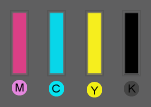
note:Ink level warnings and indicators provide estimates for planning purposes only. When an indicator shows low ink levels, consider having a replacement ink cartridge available to avoid possible printing delays. You do not need to replace ink cartridges until you are prompted to.
-
If none of the ink cartridges are low on ink, you do not need to replace them yet. Continue to the next solution.
-
If any of the ink cartridges are low on ink, continue to the next step to replace them.
Step 2: Replace any depleted cartridges
Replace any depleted cartridges, and then try to print again.
-
Turn on the printer.
-
Place your fingers into the slot on the left side of the printer, and then pull to open the cartridge access door.
The carriage moves to the left side of the printer.
-
Slot for opening the cartridge access door
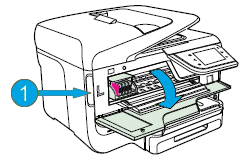
-
-
Wait until the carriage is idle and silent.
-
Push in on the front of the cartridge to release it, and then pull it toward you to remove it from its slot.
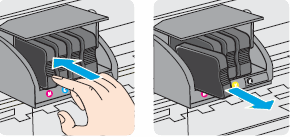
-
Remove the new cartridge from its package.
-
Hold the new cartridge so that the cartridge contacts face the printer.
-
Slide the new ink cartridge into its slot, and then gently push it forward until it snaps into place. Make sure the letter on the ink cartridge matches the letter on the slot.
caution:
Do not lift the latch handle on the carriage to insert ink cartridges. Doing so could cause the printhead or ink cartridges to be incorrectlyseated, which could damage the print mechanism and cause printing problems.
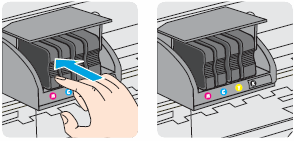
-
Repeat these steps to install any other new cartridges.
-
Close the cartridge access door.
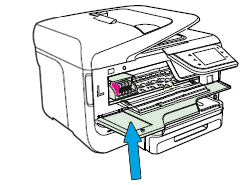
Solution six: Print and evaluate a diagnostic page, and then troubleshoot defects
Print a Print Quality Diagnostic Page, and then evaluate the results.
Step 1: Print a Print Quality Diagnostic Page
Print a Print Quality Diagnostic Page to identify the print quality issue.
-
Load plain white paper into the tray.
-
On the printer control panel, swipe the display to scroll to Setup, and then touch the Setup icon (
 ). The Setup menu displays.
). The Setup menu displays. -
Swipe the display to scroll to Print Reports, and then touch Print Reports.
-
Touch Print Quality Report. The printer prints a test page.
Figure : Example of a Print Quality Diagnostics Page

Step 2: Examine Test Pattern 1
Examine the gray columns in Test Pattern 1.
Figure : Test Pattern 1 with white gaps in the columns
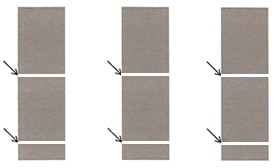
-
If the columns in Test Pattern 1 display dark lines or white gaps where the arrows are pointing, continue to the next step.
Step 3: Align the printhead
Use an automated tool to align the printhead.
-
Load plain white paper into the tray.
-
On the printer control panel, swipe the display to scroll to Setup, and then touch the Setup icon (
 ). The Setup menu displays.
). The Setup menu displays. -
Swipe the display to scroll to Tools, and then touch Tools.
-
Touch Align Printhead.
-
After the printer prints the alignment page, touch OK, and then recycle or discard the alignment page.
-
Print another Print Quality Diagnostic Page to see if the issue is resolved.
How to print a Print Quality Diagnostic Page
-
Load plain white paper into the tray.
-
On the printer control panel, swipe the display to scroll to Setup, and then touch the Setup icon (
 ). The Setup menu displays.
). The Setup menu displays. -
Swipe the display to scroll to Print Reports, and then touch Print Reports.
-
Touch Print Quality Report. The printer prints a test page.
-
If there are no defects on the page, you do not need to continue troubleshooting.
-
If there are still dark lines or white gaps where the arrows are pointing in Test Pattern 1, continue to the next step.
Step 4: Calibrate the linefeed
Use an automated tool to calibrate the linefeed.
-
On the printer control panel, swipe the display to scroll to Setup, and then touch the Setup icon (
 ). The Setup menu displays.
). The Setup menu displays. -
Swipe the display to scroll to Tools, and then touch Tools.
-
Touch Calibrate Linefeed.
-
After the printer prints a test page, touch OK, and then recycle or discard the test page.
-
Print another Print Quality Diagnostic Page to see if the issue is resolved.
How to print a Print Quality Diagnostic Page
-
Load plain white paper into the tray.
-
On the printer control panel, swipe the display to scroll to Setup, and then touch the Setup icon (
 ). The Setup menu displays.
). The Setup menu displays. -
Swipe the display to scroll to Print Reports, and then touch Print Reports.
-
Touch Print Quality Report. The printer prints a test page.
-
If there are no defects on the page, you do not need to continue troubleshooting.
-
If the lines in Test Pattern 2 are not straight and connected, continue to the next step.
Step 5: Examine Test Pattern 2
Evaluate Test Pattern 2 to make sure that the lines are straight and connected.
Figure : Test Pattern 2

-
If the lines in Test Pattern 2 are straight and connected, skip to the step to examine Test Pattern 3.
-
If the lines in Test Pattern 2 are not straight and connected, continue with the steps to align the printhead.
Step 6: Align the printhead
Use an automated tool to align the printhead.
-
Load plain white paper into the tray.
-
On the printer control panel, swipe the display to scroll to Setup, and then touch the Setup icon (
 ). The Setup menu displays.
). The Setup menu displays. -
Swipe the display to scroll to Tools, and then touch Tools.
-
Touch Align Printhead.
-
After the printer prints the alignment page, touch OK, and then recycle or discard the alignment page.
-
Print another Print Quality Diagnostic Page to see if the issue is resolved.
How to print a Print Quality Diagnostic Page
-
Load plain white paper into the tray.
-
On the printer control panel, swipe the display to scroll to Setup, and then touch the Setup icon (
 ). The Setup menu displays.
). The Setup menu displays. -
Swipe the display to scroll to Print Reports, and then touch Print Reports.
-
Touch Print Quality Report. The printer prints a test page.
-
If the lines in Test Pattern 2 are straight and connected, there is no need to continue troubleshooting.
-
If any of the color blocks in Test Pattern 3 show white lines or are faded or missing completely, continue to the next step.
Step 7: Examine Test Pattern 3
Examine the color blocks in Test Pattern 3 on the Print Quality Diagnostic Page.
Figure : Test Pattern 3 with a missing color block

-
If the color blocks in Test Pattern 3 do not show white lines, and are not faded or missing, skip to the solution to check the image.
-
If any of the color blocks in Test Pattern 3 show white lines or are faded or missing completely, continue with the steps to clean the printhead.
Step 8: Clean the printhead
Use an automated tool to clean the printhead.
caution:Never turn off the printer when ink cartridges are not installed. To avoid issues that require cleaning the printhead or that can damage the ink system, always replace ink cartridges as soon as possible, and always turn off the printer using the Power button.
-
Load plain white paper into the tray.
-
On the printer control panel, swipe the display to scroll to Setup, and then touch the Setup icon (
 ). The Setup menu displays.
). The Setup menu displays. -
Swipe the display to scroll to Tools, and then touch Tools.
-
Touch Clean Printhead. There are three cleaning stages. A test page (different from the Print Quality Diagnostics page) prints between each cleaning stage. Do not use this test page for analysis. Touch No when prompted to continue the next level of cleaning.
note:
Mechanical noises during the cleaning process are normal.
-
Print another Print Quality Diagnostics Page to determine if the issue is resolved.
How to print a Print Quality Diagnostic Page
-
Load plain white paper into the tray.
-
On the printer control panel, swipe the display to scroll to Setup, and then touch the Setup icon (
 ). The Setup menu displays.
). The Setup menu displays. -
Swipe the display to scroll to Print Reports, and then touch Print Reports.
-
Touch Print Quality Report. The printer prints a test page.
-
If there are no defects in Test Pattern 3, you do not need to continue troubleshooting.
-
If there are defects in Test Pattern 3, try cleaning the printhead again.
-
If there are still defects in Test Pattern 3 after another cleaning, you can try to clean the printhead again or skip to the solution to service the printer.
Solution seven: Check the image
Check the image for any print quality issues.
-
If you do not see defects on the test page, the print mechanism and ink cartridges work correctly. Do not continue the troubleshooting steps in this document. If printouts are still unsatisfactory, try the following general print quality guidelines.
-
Make sure that the image you are printing has sufficient resolution. Images that are enlarged too much might appear fuzzy or blurry.
-
If the issue is confined to a band near the edge of a printout, use the software you installed with the printer or another software program to rotate the image 180 degrees. The problem might not display on the other end of the printout.
-
-
If you see one or more of these defects on the test page, continue to the next step.
Solution eight: Replace the printhead
If you have completed all of the troubleshooting steps and are still experiencing a problem, replace the printhead.
caution:Wait until you have a new printhead assembly available before removing the cartridges. HP recommends that you do not leave the cartridges outside the printer longer than 30 minutes. This could damage both the printer and the cartridges.
Step 1: Check the printhead warranty status
If you have a defective cartridge or printhead, it might be under warranty. To check the warranty on your ink or toner supplies, go to Printer and Page Yield Overview, and then review the limited warranty information for your supplies.
Step 2: Order the printhead
If HP replaces your printhead assembly under warranty, you will receive a kit with a new printhead assembly, instructions, and a full set of SETUP ink cartridges. If you are an HP Instant Ink subscriber, you might also receive a new set of Instant Ink cartridges. You must install the SETUP ink cartridges first, or an ink cartridge error occurs.
-
If you are in Asia Pacific, the site directs you to a service center in your area.
-
Search for your printhead number.
-
In Canada, Latin America, and United States, search for CR322A.
-
In Europe, Middle East, and Africa, search for CR324A.
-
-
Follow the instructions to order the printhead assembly.
Step 3: Replace the printhead
-
If these steps resolved the issue, you do not need to continue troubleshooting.
-
If the issue persists, continue to the next solution.
Solution nine: Service the printer
Service or replace your HP product if the issue persists after completing all the preceding steps.
Go to Contact HP Customer Support to schedule a product repair or replacement. If you are in Asia Pacific, you will be directed to a local service center in your area.
To confirm your warranty status, go to HP Product Warranty Check. Repair fees might apply for out-of-warranty products.
note:Keep a print sample that shows the problem. If the ink cartridges, printhead, or printer is replaced under warranty, the support agent will request the print sample. If the printer is returned to HP, the print sample must be returned with the printer. Place the sample in the output tray when you package your printer for shipping.
How To Clean Printhead On Hp Officejet Pro 8620
Source: https://support.hp.com/id-en/document/c04089796
Posted by: goldmanyouss1951.blogspot.com

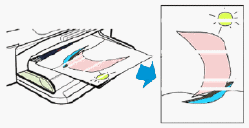
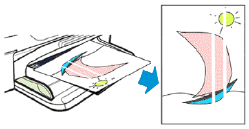
0 Response to "How To Clean Printhead On Hp Officejet Pro 8620"
Post a Comment